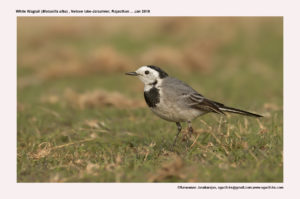White Wagtail

White Wagtail Motacilla alba
Etymology:
- Motacilla : Greek word muttextype of birdmentioned by Hesychius. It is a diminutive of motare, ” to move about”, from medieval times it led to the misunderstanding of cilla as “tail”.
- Alba : Latin word for White
Vernacular Names:Hindi: Dhoban, Sans: Bharat shwetkhajjan, Kash: Peenchkani, Dobbai, Buyachin, Pun: Chittamamola, M.P.: Khanjana, Garachanchir, Bhil: Nachangol, Ben: Khanjana, Ass: Tipochi, Lepcha: Tangzhenfleu, Guj: Khatrianni, Diwali ghodo, Mar: Pandhra dhobi/parit, Te: Wellakampajitta, Mal: Vellavalkulukki, Kan: Bilisipilae, Kundikusuka
Distribution in India:Breeds in Himalayas and wide spread winter visitor in India.
Description: Size of 16·5–18 cm; male weighs 20–24·6g, female weighs 17·6–21·9g. The male of nominate race in breeding plumage has mid-crown to nape and hindneck as black, chin and throat is black, rest of head is white; mantle and scapulars to uppertail-coverts are grey; wings are greyish-black, tertials are broadly edged white, broad white fringes on median and greater wing-coverts. The central pair of rectrices are black, narrowly fringed white, next three pairs are black, outer two pairs are white with dark wedge on inner web. The black of throat extends down to breast; rest of underparts are white, washed greyish on breast side and flanks; iris is blackish-brown; bill and legs are black. The breeding female differs from male in slightly duller head pattern, sometimes some grey on crown, usually some grey on nape, thus less contrast with mantle, often some pale spots on throat. Both sexes in non-breeding plumage have olive-grey wash on crown and nape, white chin, throat and upper breast with some black mottling. The immature has brownish-grey head, dusky moustachial stripe, greyish-white chin and throat, rest of underparts are also greyish-white, sometimes tinged buffy, with narrow dark grey-brown gorget.
Habitat: It is found in wide variety of non-forested wet and dry habitats, including seashores, rocky or sandy upland rivers and slow-moving lowland rivers, lakeshores, farmland, gardens, parks, short grassland such as that found in vicinity of factories in towns and cities; frequently around human habitations in towns and villages. On migration and in winter months, also found in edges of reservoirs, lakes, ponds and sewage works, wells in deserts, irrigated fields and rice fields, as well as in wide variety of open short grasslands and other sites in towns and villages, at campsites and on beaches. It roosts communally in trees, sometimes in reedbeds; often on or inside buildings, such as factories and glasshouses, in urban areas. It breeds from lowlands to mountains, up to 5700 m.
Food habits: It eats small terrestrial and aquatic invertebrates, ranging from weevils and other beetles, dragonflies ,adult and larval flies, termites and ants, spiders ,small snails, crustaceans and worms, fish fry; crumbs and other household scraps also taken. It forages while walking, readily exploiting lawns, bare areas, roads and pavements, roofs and other open areas. It picks at items on the ground or darts forwards (run-picking) to snatch prey; jumps up to take insects in the air or makes short flights to catch aerial prey (flycatching). It sometimes wades in shallow water, picking invertebrates from the surface or in mud, or hovers over water or vegetation to snatch prey. It also forages amidst seaweed along tideline. It follows ploughs on farmland. It is found singly or in pairs.
Breeding habits:
They breed in Apr to Aug, Apr to Jul in South & South-East Europe, Apr–Jun in Morocco and May to Aug in South Asia. They are monogamous and strictly territorial, and highly aggressive towards both conspecifics and congeners. The nest is built by both sexes. The nest is a rough cup of twigs, grass stems, leaves, rootlets and mosses, lined with hair, wool or feathers, sited in hole or crevice in riverbank, wall or bridge, and often in building or even in machinery. They lay a clutch of 3–8 eggs . The incubation is done by parents, female taking greater share and she alone sitting at night. The incubation period is 11–13 days. The chicks aref ed by both parents for 11–16 days. The fledglings arefed by parents for up to 1 week.